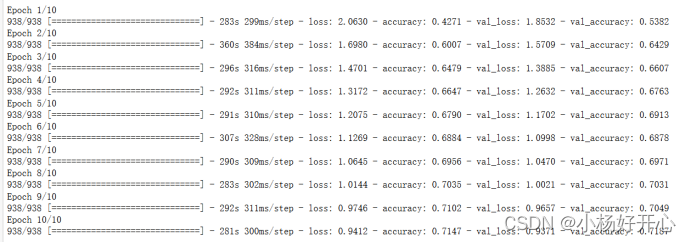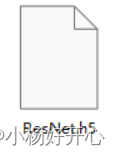一、ResNet
1.导入包
python
import tensorflow as tf
from tensorflow.keras import layers, models, datasets, optimizersoptimizers是用于更新模型参数以最小化损失函数的算法
2.加载数据集、归一化、转为独热编码的内容一致
3.增加颜色通道
python
train_images = train_images[..., tf.newaxis].astype("float32")
test_images = test_images[..., tf.newaxis].astype("float32")在train_images和test_images最后一个维度增加一个新的维度
这两行代码还将图像数据转换为浮点数类型
4.定义一个用于图像预处理的模型
4.1创造模型
python
preprocessing = models.Sequential([4.2添加一个卷积层,该层有3个1x1的卷积核,激活函数为relu,并且指定了输入形状为28x28像素的单通道图像
python
layers.Conv2D(3, (1, 1), activation='relu', input_shape=(28, 28, 1)),4.3 将图像尺寸增加到56x56
python
layers.UpSampling2D((2, 2)),
])5.应用预处理模型到训练和测试图像上
python
train_images = preprocessing(train_images)
test_images = preprocessing(test_images)6.加载ResNet50模型并冻结所有层
python
base_model=tf.keras.applications.ResNet50(weights='imagenet',include_top=False,input_shape=(56, 56, 3))ResNet50是一个预训练的卷积神经网络模型,
参数1:加载模型的权重
参数2:是否包括模型顶部的全连接层,设置False意味着不包括这些层,由此可以得到模型的特征提取部分
参数3:输入图像的尺寸
base_model.trainable = False
使ResNet50模型的所有层都不可训练
7.创建模型
python
model = models.Sequential([7.1放在模型的第一层添加到序列中,用于提取图像特征
python
base_model,7.2在Keras中添加的一个全局平均池化层
python
layers.GlobalAveragePooling2D(),7.3在Keras中添加的一个全连接层,使用softmax为激活函数
python
layers.Dense(10, activation='softmax')
])8.编译模型
python
model.compile(optimizer=optimizers.Adam(),
loss='categorical_crossentropy',
metrics=['accuracy'])- 和上一个博客的模型的内容一样,此处省略
9.训练模型
python
model.fit(train_images, train_labels, epochs=10, batch_size=64, validation_data=(test_images, test_labels))结果:

10.保存文件
python
model.save('ResNet.h5')结果:
